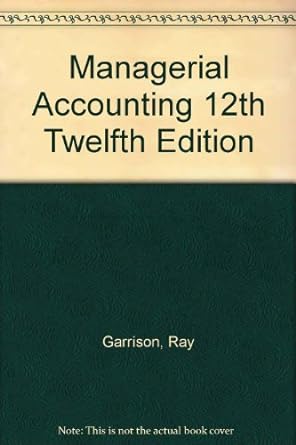Question
GIVEN: Kann Corporation produces industrial robots for high-precision manufacturing. The following information is available: Per Unit Total Direct materials $25.00 Direct labor $10.00 Variable manufacturing
GIVEN: Kann Corporation produces industrial robots for high-precision manufacturing. The following information is available:
Per Unit Total
Direct materials $25.00
Direct labor $10.00
Variable manufacturing overhead $6.00
Fixed manufacturing overhead $36,000
Variable selling and administrative costs $4.00
Fixed selling and administrative costs $15,000
The company has a desired ROI of 20%. It has invested assets of $420,000. It anticipates making and selling 3,000 units per year.
REQUIRED:
Part 1: Using the total (full) cost concept, determine the (a) unit cost amount; (b) markup percentage; and (c) unit target selling price.
Part 2: Using the product (absorption) cost concept, determine the (a) unit cost amount; and (b) markup percentage.
Part 3: Using the variable cost concept, determine the (a) unit cost amount; and (b) markup percentage.
Part 4: What is the target unit selling price under the three cost assumptions?
Part 5: What else should be considered when setting the product's selling price?
Part 6: Which of the three costing concepts would be most appropriate in each of the following situations? 1. External reporting for GAAP 2. Normal (long-run) pricing 3. Evaluating special orders
Part 7: Kann Corporation received a special order for 500 robots at $50 each from a foreign customer. Acceptance of the order would increase variable selling costs by $1.70 per unit because of shipping costs, but would not increase fixed costs or interfere with any current orders. Prepare a differential analysis to determine whether the special order should be accepted or not.
My school has no tutors for this; I will post what little I have, and attempt more myself, but I really do not know what I'm doing. I do not know how these figures that I have were determined:
| Full cost for 3000 units | Absorption cost for 3000 units | Variable costs for 3000 units | |||||||||
| Direct materials | $75,000 | $75,000 | $75,000 | ||||||||
| Direct labor | 30,000 | 30,000 | 30,000 | ||||||||
| Variable manufacturing overhead | 18,000 | 18,000 | 18,000 | ||||||||
| Fixed manufacturing overhead | 36,000 | 36,000 | |||||||||
| Variable selling overhead | 12,000 | 12,000 | |||||||||
| Fixed selling overhead | 15,000 | ||||||||||
| Total cost | 186,000 | 159,000 | 135,000 | ||||||||
| Cost per unit | 62 | 53 | 45 | ||||||||
| Desired profit = 42,000 * 20% | 84,000 | 84,000 | 84,000 | ||||||||
| Sales value | 270,000 | 243,000 | 219,000 | ||||||||
| Sales price per unit | 90 | 81 | 73 | ||||||||
Step by Step Solution
There are 3 Steps involved in it
Step: 1

Get Instant Access to Expert-Tailored Solutions
See step-by-step solutions with expert insights and AI powered tools for academic success
Step: 2

Step: 3

Ace Your Homework with AI
Get the answers you need in no time with our AI-driven, step-by-step assistance
Get Started


